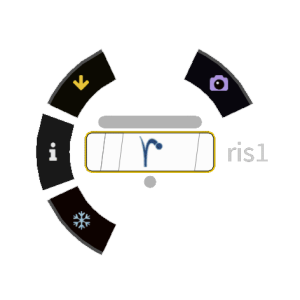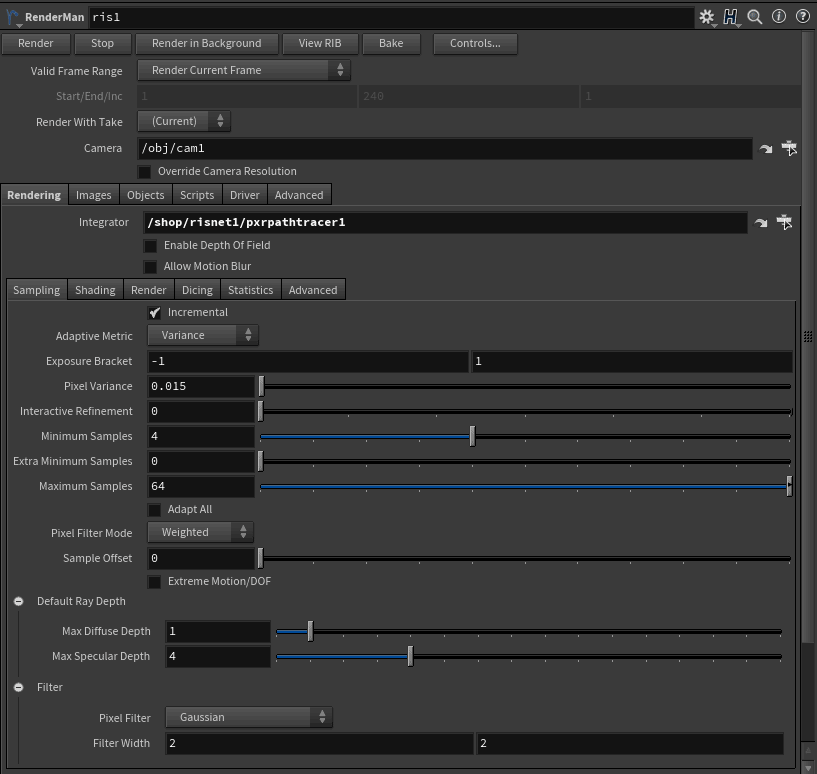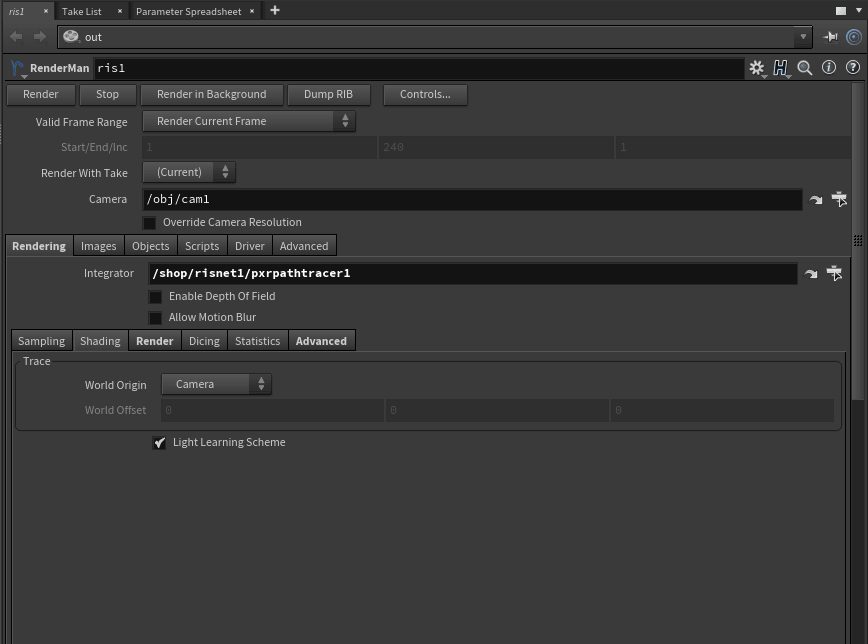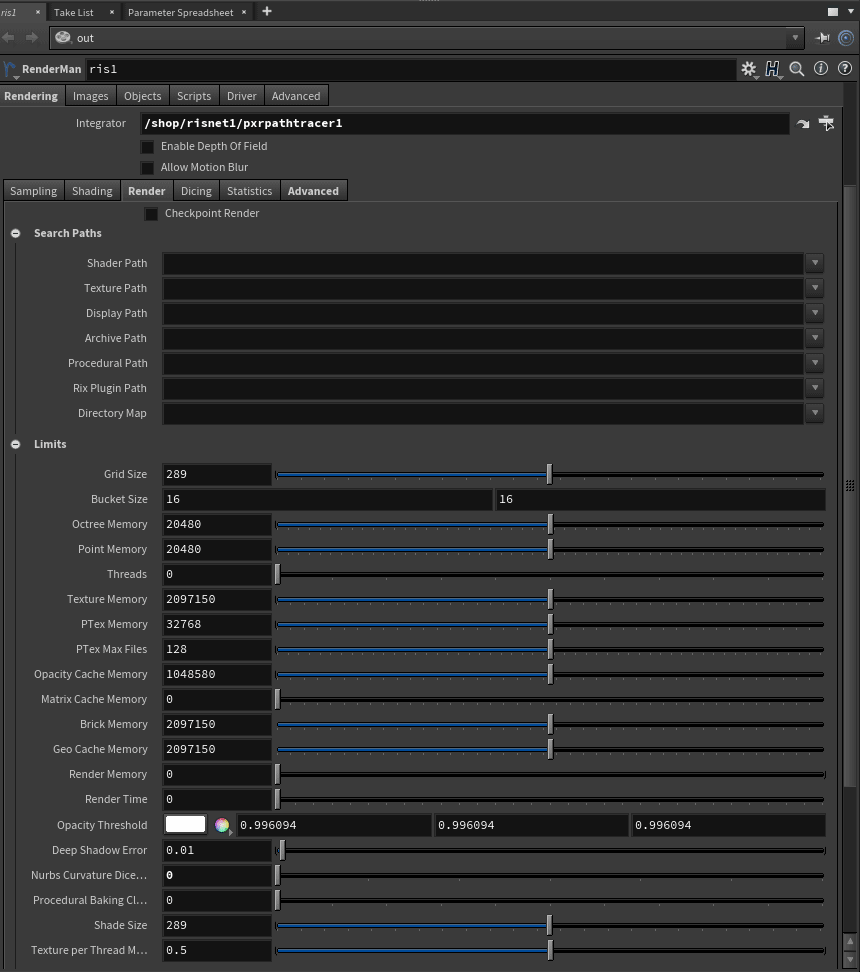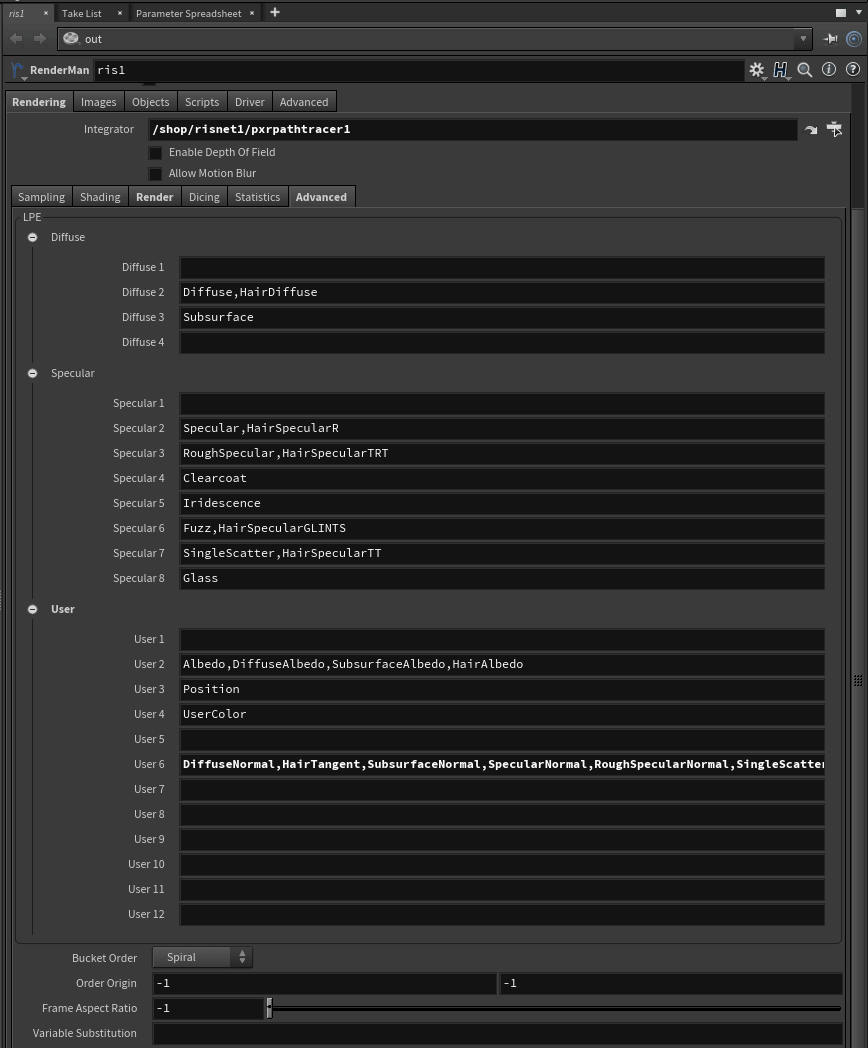Contents
Rendering in RenderMan is accomplished using the ROP node in Houdini. If you choose the shelf button, we will create and connect the common choices for rendering including using the PxrPathTracer Integrator.
There are many options for rendering and some are obscure or for special circumstances. We support having multiple ROP nodes in Houdini so that you can tailor each one to your task, be it IPR settings, different display drivers for render passes, or useful changes you'd like to see as you render. Be sure to use the render controls of the ROP node you are wishing to view the results from. As an example, you could create a ROP node with settings designed for fast IPR and another for final production renders.
This document aims to help you navigate the differences as simply as possible.
Standard Controls
Buttons
- Render: Initiate an Interactive Render to RenderMan
- Stop: Cancel or End the interactive render (you may also stop the render from "it")
- Render in Background: Render while keeping the Houdini UI available
- View Rib: Export a RIB file (defaults to the location of your .hip scene file) The default is Binary to save space. You may change this in the RIB Tab
- Bake: Run a bake render to bake pattern networks
- Controls...: Additional options for rendering like quality overrides and frame settings
Common Choices
- Valid Frame Range: Choose the frames to render, not valid for interactive rendering
- Start/End/Inc: The frame range and increments, accepts floating point values
- Render With Take: Which versioning to use
- Camera: Path to the chosen camera from which to render. This must have a camera specified. If using our shelf button, we will populate the field
- Override Camera Resolution: Change the render resolution from the one specified in the camera settings
Rendering
- Integrator: What integrator to use. If this is empty or not set, we use the PxrDefault Integrator
- Enable Depth of Field: Allows the use of Depth of Field settings, this is an easy on/off setting should you want to disable it for scene tweaking
- Allow Motion Blur: Turns on motion blur for scene entities. Please note the motion blur of volumes is controlled by the BxDF, PxrVolume separately
Sampling Tab
See also Renderer Options for more details
- Incremental: Render frame passes instead of bucket/tile based rendering. Preferred for most rendering choices including batched and checkpointed renders
- Adaptive Metric: Choose the sampling method for the adaptive sampler
- Exposure Bracket (variance): The minimum exposure bracket is used to determine a max intensity beyond which any intensity variance or contrast or difference won't matter visually. Also, the max exposure bracket is used to determine how far "down" the gamma correction curve we need to go for the max derivative assuming the composited result is inside this range
- Dark Falloff (contrast): If an area of the image is darker than this threshold, stop sampling since it won't be visible or perceived
- Pixel Variance: This is your main quality control for the render. Lower values are higher quality. Typical production settings are 0.01 to 0.005 (extreme high quality). 0.015 is reasonable good to medium quality depending on scene complexity
- Interactive Refinement: How aggressive the renderer is allowed to be in coarsely sampling a frame during interactive rendering. Higher numbers are more aggressive/blurry before the converge
- Sampling
- Minimum Samples: The lowest number of sample required per-pixel. A value of 0 takes the nearest square root of the Maximum Samples setting. Higher numbers may be necessary to capture small image features like small particles or thin hair
- Extra Minimum Samples: If a pixel fails the variance test, this value forces a specified number of additional samples before testing the variance again. At 0 it defaults to the same number as the Minimum Samples
- Maximum Samples: The most samples we will take before stopping samples on a pixel. Higher values may be necessary when rendering depth of field, motion blur, or other noisy effects
- Adapt All: Test all the AOVs against the variance threshold. This means your AOVs are more likely to be noise-free but can significantly increase render times as some AOVs may trigger more samples without much gain to image quality
- Pixel Filter Mode
- Weighted: This is the default setting where samples are filtered together
- Importance: This is required for denoising applications (Hyperion or Nvidia) where pixels are independent of one another
- Sample Offset: This allows several images to be rendered in parallel (with different sampleoffset values) and then combined
- Extreme Motion/DOF: Changed the sampling technique when depth of field or motion blur is extreme/dominant in the image. This is more accurate but introduces some overhead
- Default Ray Depth: The default depths per scattering type (diffuse or specular) to apply globally to all objects in the scene. Object attributes may override this value but not the Max Depth of the Integrator
- Filter: The type and window size of the parent image filter, the default of Gaussian 2.0 2.0 is typically best for most everything
Shading
See also Renderer Options for more details
- Trace
- World Origin: Allows the user to select the origin fr the scene, useful for very large scenes where precision issues may cause slow renders or artifacts in raytracing
- Camera: The default uses the render camera position as the world origin (0, 0, 0)
- World: The original default where your scene grid is used as the origin for your scene
- World Offset: User supplied coordinates as the new origin for the scene during rendering
- World Offset: The user defined location of the new scene origin if World Offset is chosen above
- World Origin: Allows the user to select the origin fr the scene, useful for very large scenes where precision issues may cause slow renders or artifacts in raytracing
- Light Learning Scheme: This option allows the renderer to use light attributes and positions/occlusion to inform the renderer of how to balance samples across the scene to improve convergence. Complex scenes benefit more than simple scenes or scenes with few lights
Render
See also Renderer Options for more details
- Checkpoint Render: Batch render a scene while incrementally leaving checkpoint files for viewing or restarting later
- Search Paths: These point to locations where RenderMan should look for custom plugins, image directories, and more
- Shader Path: Path to find shader plugins
- Texture Path: Path to search for texture files
- Display Path: Path to find Display plugins
- Archive Path: Path for finding and loading delayed read archives/RIB
- Procedural Path: Path to find procedural plugins (like Maya's Xgen)
- Rix Plugin Path: Path to other RenderMan plugins
- Directory Map: Path remapping
- Limits: These define memory limits for certain features of the renderer. On modern machines you may have enough memory to hold most entities in RAM, but for some parts of the render you may be able to efficiently reduce the memory used to render large scenes (geometry must be in-memory) We attempt to set this at reasonable limits by default. For more information, look under Configuration
Dicing
See also Renderer Options for more details
- Minimum Width: Minimum pixel width to render hair/fur/curves. A small amount may improve anti-aliasing of fine curves
- Offscreen Multiplier: The multiplier of the dicing rate for objects offscreen that may appear to have poor shape in reflections or cast shadows that are from obviously under-diced objects
Statistics
See also Renderer Options for more details
- Debug: Allow shading debug messages
- Render Statistics: Output render stats on render completion
Advanced
See also Renderer Options for more details
- LPE: This section defines lobes for output to LPE, this includes the lobes from PxrSurface and PxrMarschnerHair. Custom materials may also define lobes for output here as User lobes. Note that the 1 position for each set, Diffuse, Specular, and User is empty as a fall through
- Bucket Order: Render bucket order. Supported values: horizontal, vertical, zigzag-x, zigzag-y, spacefill, random, spiral, circle
- Order Origin: Specify the first bucket/tile rendered when using Spiral or Circle choices
- Frame Aspect: The aspect ratio of the rendered output image
- Variable Substitution: Meant for RIB file parsing only

